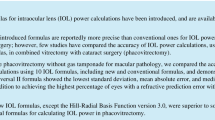Purpose
To assess the correlations between preoperative Scheimpflug-based lens densitometry and effective phacoemulsification time (EPT) in age-related nuclear cataracts.
Design
Retrospective consecutive study.
Methods
The setting was the Ophthalmology Department, Hospital de Braga, Portugal. The study population included 50 eyes (42 patients) with age-related nuclear cataracts submitted to uneventful phacoemulsification surgery. Different analysis methods of Scheimpflug-based lens densitometry were performed: Pentacam Nucleus Staging (PNS) score with an ordinal scale from 0 to 5 and three-dimensional (3D), linear and region of interest (ROI) methods, which are displayed on an absolute scale (from 0 to 100%). EPT was calculated for the cataract surgery, which was performed by the same surgeon. Correlations between lens densitometry variables and EPT were determined using Pearson or Spearman correlation coefficients according to data normality.
Results
There were significant correlations between EPT and average density and maximum density variables derived from the 3D (r = 0.596, p < 0.001; r = 0.632, p < 0.001, respectively) and ROI (r = 0.527, p < 0.001; r = 0.575, p < 0.001, respectively) methods. The average density was the only parameter derived from the linear analysis that showed a significant correlation with EPT (r = 0.293, p = 0.039). The PNS score did not show a significant correlation with EPT (rho = 0.124, p = 0.390).
Conclusion
The densitometric parameters based on the 3D method showed the highest correlations with EPT. The referred lens densitometric analysis approach may be used in preoperative assessment in order to predict EPT more efficiently in age-related nuclear cataracts.




Similar content being viewed by others
References
Karbassi M, Khu PM, Singer DM, Chylack LT Jr (1993) Evaluation of lens opacities classification system III applied at the slitlamp. Optom Vis Sci 70(11):923–928
Chylack LT Jr, Wolfe JK, Singer DM et al (1993) The lens opacities classification system III. The Longitudinal Study of Cataract Study Group. Arch Ophthalmol 111(6):831–836
Chylack LT Jr, Wolfe JK, Friend J et al (1995) Validation of methods for the assessment of cataract progression in the Roche European-American Anticataract Trial (REACT). Ophthalmic Epidemiol 2(2):59–75
Davison JA, Chylack LT (2003) Clinical application of the lens opacities classification system III in the performance of phacoemulsification. J Cataract Refract Surg 29(1):138–145
Datiles MB 3rd, Magno BV, Freidlin V (1995) Study of nuclear cataract progression using the National Eye Institute Scheimpflug system. Br J Ophthalmol 79(6):527–534
Kirkwood BJ, Hendicott PL, Read SA, Pesudovs K (2009) Repeatability and validity of lens densitometry measured with Scheimpflug imaging. J Cataract Refract Surg 35(7):1210–1215
Magno BV, Freidlin V, Datiles MB 3rd (1994) Reproducibility of the NEI Scheimpflug cataract imaging system. Invest Ophthalmol Vis Sci 35(7):3078–3084
Weiner X, Baumeister M, Kohnen T, Buhren J (2014) Repeatability of lens densitometry using Scheimpflug imaging. J Cataract Refract Surg 40(5):756–763
Ortiz D, Alio JL, Ruiz-Colecha J, Oser U (2008) Grading nuclear cataract opacity by densitometry and objective optical analysis. J Cataract Refract Surg 34(8):1345–1352
Pei X, Bao Y, Chen Y, Li X (2008) Correlation of lens density measured using the Pentacam Scheimpflug system with the Lens Opacities Classification System III grading score and visual acuity in age-related nuclear cataract. Br J Ophthalmol 92(11):1471–1475
Gupta M, Ram J, Jain A, Sukhija J, Chaudhary M (2013) Correlation of nuclear density using the Lens Opacity Classification System III versus Scheimpflug imaging with phacoemulsification parameters. J Cataract Refract Surg 39(12):1818–1823
Kim JS, Chung SH, Joo CK (2009) Clinical application of a Scheimpflug system for lens density measurements in phacoemulsification. J Cataract Refract Surg 35(7):1204–1209
Lim SA, Hwang J, Hwang KY, Chung SH (2014) Objective assessment of nuclear cataract: comparison of double-pass and Scheimpflug systems. J Cataract Refract Surg 40(5):716–721
Magalhaes FP, Costa EF, Cariello AJ, Rodrigues EB, Hofling-Lima AL (2011) Comparative analysis of the nuclear lens opalescence by the Lens Opacities Classification System III with nuclear density values provided by Oculus Pentacam: a cross-section study using Pentacam Nucleus Staging software. Arq Bras Oftalmol 74(2):110–113
Fine IH, Packer M, Hoffman RS (2001) Use of power modulations in phacoemulsification. Choo-choo chop and flip phacoemulsification. J Cataract Refract Surg 27(2):188–197
Nixon DR (2010) Preoperative cataract grading by Scheimpflug imaging and effect on operative fluidics and phacoemulsification energy. J Cataract Refract Surg 36(2):242–246
Mayer WJ, Klaproth OK, Hengerer FH, Kohnen T (2014) Impact of crystalline lens opacification on effective phacoemulsification time in femtosecond laser-assisted cataract surgery. Am J Ophthalmol 157(2):426–432
Grewal DS, Brar GS, Grewal SP (2009) Correlation of nuclear cataract lens density using Scheimpflug images with Lens Opacities Classification System III and visual function. Ophthalmology 116(8):1436–1443
Wong AL, Leung CK, Weinreb RN et al (2009) Quantitative assessment of lens opacities with anterior segment optical coherence tomography. Br J Ophthalmol 93(1):61–65
Braga-Mele R, Chang D, Dewey S et al (2014) Multifocal intraocular lenses: relative indications and contraindications for implantation. J Cataract Refract Surg 40(2):313–322
Author information
Authors and Affiliations
Corresponding author
Ethics declarations
Conflict of interest
Dr. Ambrósio is a consultant for Oculus (Wetzlar, Germany), Alcon (Fort Worth, Texas, USA) and Carl Zeiss Meditec (Jena, Germany). Other authors have no financial disclosures to state.
Rights and permissions
About this article
Cite this article
Faria-Correia, F., Lopes, B., Monteiro, T. et al. Correlation between different Scheimpflug-based lens densitometry analysis and effective phacoemulsification time in mild nuclear cataracts. Int Ophthalmol 38, 1103–1110 (2018). https://doi.org/10.1007/s10792-017-0566-7
Received:
Accepted:
Published:
Issue Date:
DOI: https://doi.org/10.1007/s10792-017-0566-7




